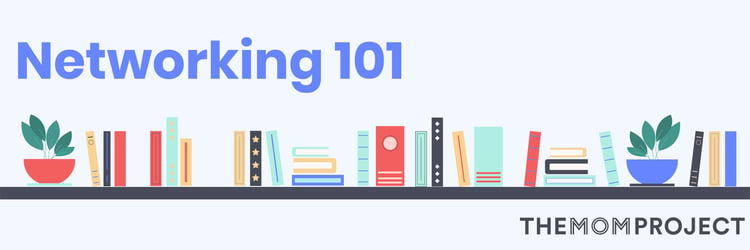No matter how much we hear about the value of building meaningful relationships throughout our careers, networking can still feel cringey and uncomfortable, evoking images of schmoozing businessmen and vague acquaintances who pop up out of the blue just to ask for favors.
But it’s time to put these misconceptions to rest. Networking isn’t about knowing when to turn on the charm and smooth-talk someone into giving you a job. And it’s not about kissing up to people in power and only talking to those who can do something for you.
Networking is about developing mutually beneficial relationships that involve both give and take. You can start building your network wherever you are, using the tools you have right now.
J. Kelly Hoey, author and host of the podcast Build Your Dream Network, joined The Mom Project for a virtual event on the art of networking where she shared advice that anyone can use to network effectively. Let’s dive into some of her major points.

Start with who you know
Start with the people you already know, especially those who care about you and want to help you overcome your challenges. Your professional network doesn’t just mean your former colleagues or alumni network—you can include anyone you know, regardless of where you know them from.
You may be tempted to steer some conversations away from work and career topics, especially when you’re talking to someone who seems so far removed from your professional life. But you can’t assume that someone you already know can’t be helpful. Sometimes we don’t share our work lives because we think that someone’s “just my personal trainer” or “just my hairdresser,” but those connections can be just as meaningful, and writing them off may cause you to miss out on a valuable opportunity. In fact, according to the Harvard Business Review, the most highly-ranked, best-networked women connect with people in a variety of functions, geographies and business units, while others tend to stick to their own team.
It’s also important to value connections with those at all professional levels, not just the ones that are more senior to you. Not only will this shift your thinking away from networking as a form of social climbing, but there’s also a lot to gain from connecting with people at your level, and even those who are less experienced than you. You can share resources, talk about trends and best practices in your field and ask to be connected with their teams or networks if you need to.
"But, what if I'm an introvert?"
Don’t confuse the ease of working a room with being a good networker, says Hoey. Being naturally outgoing doesn’t have anything to do with building strong professional relationships. Hoey says that 80% of the people she interviewed for her book, Build Your Dream Network: Forging Powerful Relationships in a Hyper-connected World—people who had moved up the corporate ladder, landed a board position or crowdfunded through successful networking—happened to be introverts. Especially in an age when we’re constantly being bombarded with information, people who are more deliberate and intentional in forming connections are often better network-builders.
How to network effectively
There’s no perfect formula or secret trick for how to be a successful networker, but there are some helpful tips that you can follow to build meaningful professional relationships.
Keep your ears open
We’re often used to thinking about what we’re going to say next, but we don’t focus enough on listening and observing. You’re not going to know how someone can fit into your network unless you pay attention. Life can get pretty busy sometimes, and it’s easy to limit our conversations to just pleasantries. You might ask how your friend’s work is going without any actual interest in hearing the details, and they might just say “it’s good,” and move on. But engaging in these dialogues can have unexpected benefits, and it’s important to make a habit of leaning into the conversation.
Know what you're looking for
From crafting cold emails and scheduling coffee chats to attending meetup events, networking can be a pretty time-consuming endeavor. And most of us are already overbooked as it is. To save time and figure out where to focus your priorities, try to settle on a clear idea of what you want—the more specific, the better.
If you’re exploring a career change, talk to some of your contacts and mutual connections who have experience in that area. You can focus your efforts on setting up calls and meetings to talk about their career stories and learn more about getting started in that field. If you can’t find anyone to talk to, search for some blogs and podcasts that talk about what it’s like to work in that role. Once you’ve figured out what you want to do, it’s time to spread the word.
Instead of going around telling people, “I’m looking for a job,” you can now tell them about the job and industry that you’d like to pursue. That way, you can look for people in your network who may be connected in that industry, and even if you don’t find a connection right away, you can plant the seeds by letting people know where you’re looking.
Follow social media etiquette
It can be challenging to gauge the proper etiquette for online interactions. Maybe you heard of someone who got a job by cold messaging professionals in their industry, but you don’t even get a response when you try it. The fact is that while cold messaging can work in some contexts, it’s usually not enough to send a generic message to get someone’s attention. Professional relationships over social media take time to develop, and you typically have to put in more effort than simply clicking the “connect” button on LinkedIn.
Hoey’s advice is to envision each social media platform as a different physical setting—Twitter is a cocktail party, Facebook is for friends and family, LinkedIn is the office and Instagram is a combination of the last two. By imagining each one as its own physical space, you can figure out the most appropriate way to engage. If you wouldn’t meet someone at a cocktail party and immediately ask for work, why would you do it on Twitter?
Show that you've done your research
It’s important to be informed when reaching out to potential contacts. To increase your chances of getting a response, think of someone you want to connect with and search around to see what they’ve been saying and doing on the internet. Try to figure out what they’re responding to, and what time of day they seem to be available and online.
You also want to show that you’re putting in effort. If you ask questions that you could easily find the answers to by scanning their LinkedIn profile, you could risk coming off as insincere. Instead, go the extra step to figure out what they’ve been up to recently and use that as a launching pad for your conversation. If most people are trying to build connections simply by adding other LinkedIn professionals, that personal touch could set you apart from the crowd.
Make a specific ask
When you reach out to people, try to make your request as clear and specific as possible. If you’re using email, try to summarize your ask in the subject line. Then, in the body of the message, lead into a brief introduction, and get to the point about how they can help you.
For example, instead of saying, “Hi, I’d love to meet up for coffee sometime,” you can opt for something that speaks to your specific needs and interests, like:
“Hi, I see that you have been in the marketing industry for some time and recently posted about your new digital ad campaign. As an aspiring digital marketer, I was wondering if you'd be willing to have a quick chat to share the top things you look for when you're hiring for junior digital marketers.”
If they deny the request because they’re too busy or don’t have the capacity to help, follow up with a more specific question.
Maintain relationships in-between asks
Your network isn’t just a contact book that you open when you need something. We all know how insincere it can seem when someone reaches out to ask for a recommendation or an introduction after you haven’t heard from them in years. You want your connections to see that you’re putting in the effort to cultivate genuine relationships by keeping in touch on a regular basis. Comment on their LinkedIn posts, shoot them an email if you see an article that could be interesting to them or recommend a new tool or platform that they might benefit from.
Make it a two-way street
Try to give as much as you take, whether it’s sending your friends jobs that fit their skill set or it’s making a personal introduction to connect two of your contacts. You can also give back by mentoring more junior professionals or reviewing friends’ resumes for positions that you’re familiar with. Offer information and expertise from your industry that your connections can use for salary negotiations or in job interviews.
Make an effort to reach out to others, even if it’s just to see how they’re doing. Especially during challenging times like these, some of the best networking you can do is just checking in with each other.
▶️ Watch: Unity Hour - The Art of Networking with J. Kelly Hoey
Join our member network
The Mom Project supports women throughout their working motherhood journey. Search for career opportunities with vetted, family-friendly employers, and get access to job search tools, career development resources and a thriving community of moms and allies. 



